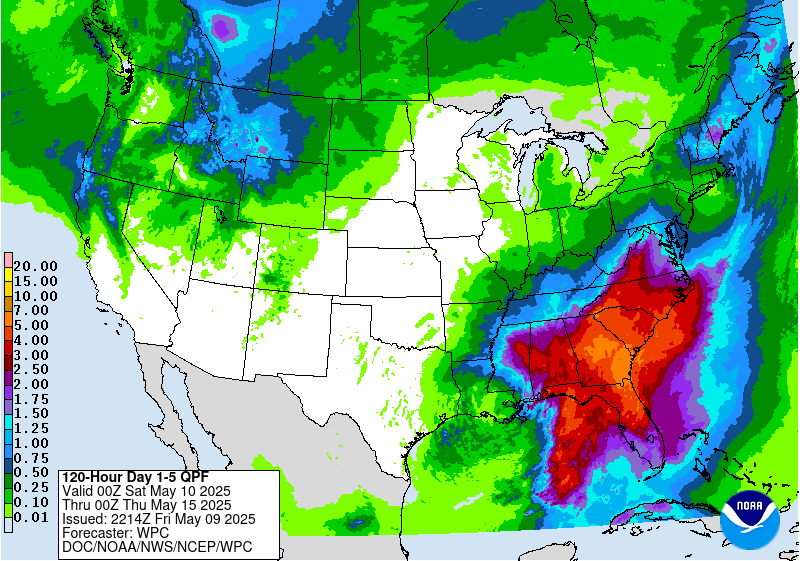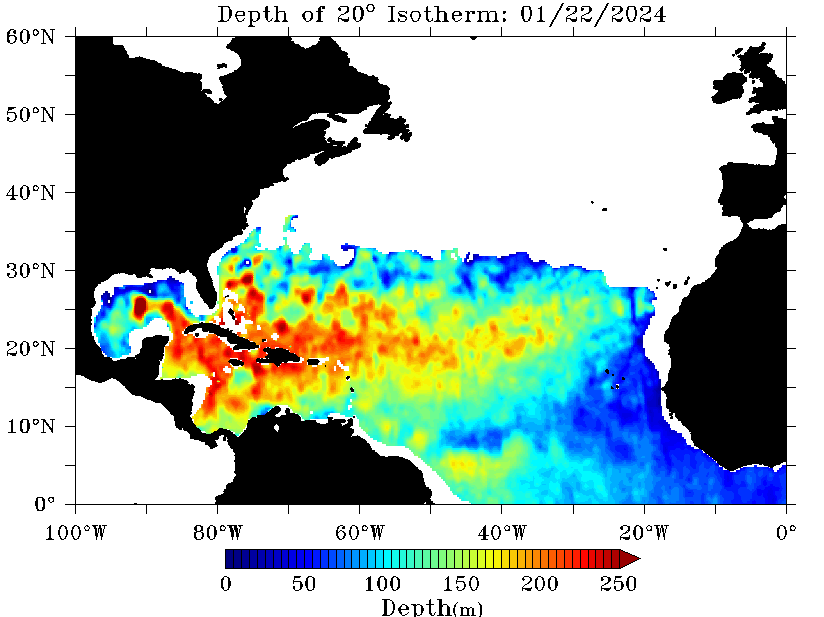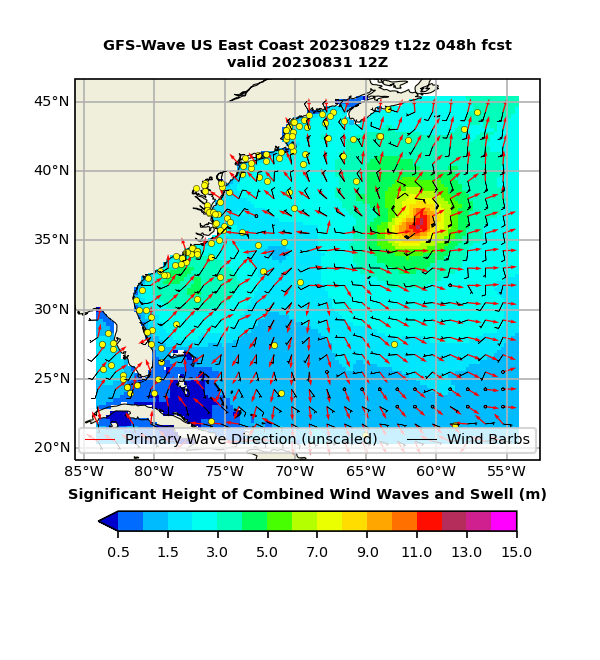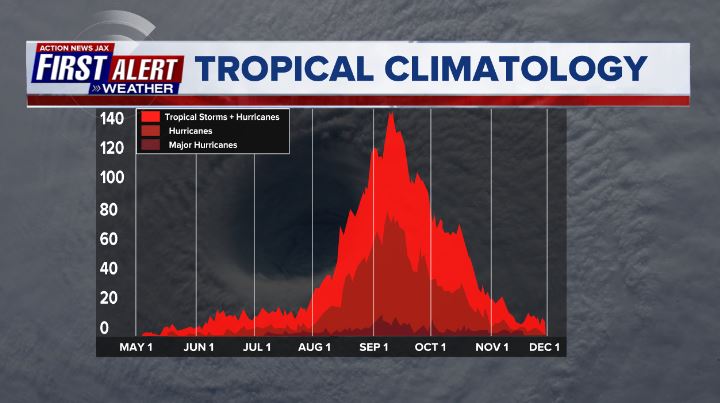Jacksonville, Fl. — The “Buresh Bottom Line”: Always be prepared!.....First Alert Hurricane Survival Guide... City of Jacksonville Preparedness Guide... Georgia Hurricane Guide.
STAY INFORMED: Get the * FREE * First Alert Weather app
FREE NEWS UPDATES, ALERTS: Action News Jax app for Apple | For Android
WATCH “The Ins & Outs of Hurricane Season”
WATCH “Preparing for the Storm”
READ the First Alert Hurricane Center “Survival Guide”
***** ALWAYS CHECK & RE-CHECK THE LATEST FORECAST & UPDATES! *****
REMEMBER WHEN A TROPICAL STORM OR HURRICANE IS APPROACHING: Taping windows is *NOT* helpful & will not keep glass from breaking... & realize the cone is the average forecast error over a given time - out to 5 days - & *does not* indicate the width of the storm &/or damage therefore do not become fixated on the center of a tropical system.
The peak of the hurricane season was Sept. 10th with a mini peak in mid Oct. There is an overall concern regarding a rather late surge in Atlantic tropical activity & potential land impacts discussed in the “Buresh Blog” * here *.
Areas to watch:
(1) Nicholas - along Gulf Coast
(2) possible tropical development over the SW or W Atlantic over the next few days.
(3) tropical waves headed west off the coast of Africa
(1) Nicholas: moved over the SW Gulf of Mexico Sun. morning & was upgraded to a tropical storm becoming a hurricane late Mon. evening upon approach to the Central Texas Gulf Coast followed by quickly by a Cat. 1 landfall at 1:30 AM EDT on the eastern part of the Matagorda Peninsula, about 10 miles (15 km) west-southwest of Sargent Beach, Texas, & the last NHC advisory was issued late Tue. evening. The low pressure area continues to slowly wind down along the Gulf Coast in Louisiana but a plume of tropical moisture to the east is still producing heavy rain.
Nicholas is the 14th named storm of this busy hurricane season. From Dr. Phil Klotzbach: “Only 4 other years in satellite era (1966 onwards) have had 14+ named storms by 12 September: 2005, 2011, 2012, 2020″.





The remnants of “Nicholas” still helping to produce heavy rain along the Gulf Coast + note the heavy rain swath offshore of the U.S. east coast in association with disturbance ‘96-L’:

(2) Forecast models continue to indicate a disturbance that is a product of an old tropical wave that moved off Africa days ago combined with an upper low with eventually consolidate into a low pressure area that would then become tropical. Though this low will be at Jacksonville’s approximate latitude through Thu. night, it will be hundreds of miles to the east with no local impacts. The Outer Banks of N. Carolina will be grazed by this system into Fri. but still well offshore so the primary threat will be onshore winds & a heightened rip current risk along the coast of the Carolina’s. Once the disturbance gets caught up in the southwesterly flow, the low will turn northeast & accelerate across the N. Atlantic. The system has a good shot at deepening but will be moving away from any land areas.



(3) Multiple tropical waves are marching west off the coast of Africa as one would expect near the peak of the season. Pockets of strong shear + some dry air will probably play a role in the intensity, but we’re likely to see a couple of tropical depressions/storms eventually develop. Positioning & strength of the Bermuda High will be critical on where these waves travel & how far west they manage to make it. At this point, it seems any systems over the next 10 days to 2 weeks will struggle to make it too far west within a somewhat marginal environment (sinking air) but obviously something to continue to track & monitor.
It’s possible a period of heightened concern for U.S. impacts will evolve toward the end of the month & especially into Oct. - more on that potential *here* in the “Buresh Blog”.

Ocean temps. remain “fit” to help maintain tropical cyclones.
Sea surface temps. across the Atlantic are now near to above avg. across much of the basin (2nd image below) & - even more importantly - deep oceanic heat content (which helped “feed” Ida) is impressive & the “equivalent oceanic heat content” - namely depth averaged temperature in the upper 300 m (~984 feet) - is even more impressive all the way from Africa to the Gulf of Mexico. Such an ocean water temp. pattern is conducive to long track deep tropical Atlantic tropical cyclones & can lead to a more favored regime for rapid intensification cycles. From an AMS research paper in ‘08 Mainelli, DeMaria, Shay, Goni: “Results show that for a large sample of Atlantic storms, the OHC variations have a small but positive impact on the intensity forecasts. However, for intense storms, the effect of the OHC is much more significant, suggestive of its importance on rapid intensification. The OHC input improved the average intensity errors of the SHIPS forecasts by up to 5% for all cases from the category 5 storms, and up to 20% for individual storms, with the maximum improvement for the 72–96-h forecasts. The statistical results obtained indicate that the OHC only becomes important when it has values much larger than that required to support a tropical cyclone.” More recent research continues to indicate similar correlations.





Saharan dust. Dry air - yellow/orange/red/pink. Widespread dust is indicative of dry air that can impede the development of tropical cyclones. However, sometimes “wanna’ be” waves will just wait until they get to the other side of the plume then try to develop if everything else happens to be favorable. In my personal opinion, way too much is made about the presence of Saharan dust & how it relates to tropical cyclones.

2021 names..... “Odette” is the next name on the Atlantic list (names are picked at random by the World Meteorological Organization... repeat every 6 years... historic storms are retired (Florence & Michael in ’18... Dorian in ’19 & Laura, Eta & Iota in ‘20). Last year - 2020 - had a record 30 named storms. The WMO decided beginning in 2021 that the Greek alphabet will be no longer used & instead there will be a supplemental list of names if the first list is exhausted (has only happened twice - 2005 & 2020). More on the history of naming tropical cyclones * here *.





East Atlantic:





Mid & upper level wind shear (enemy of tropical cyclones) analysis (CIMMS). The red lines indicate strong shear:
Water vapor imagery (dark blue indicates dry air):

Deep oceanic heat content continues to increase across the Gulf, Caribbean & deep tropical Atlantic & has become pretty impressive from the Central/NW Caribbean into the Gulf of Mexico:

Sea surface temp. anomalies:


SE U.S. surface map:

Surface analysis centered on the tropical Atlantic:

Surface analysis of the Gulf:

Caribbean:

GFS wave forecast at 48 & 72 hours (2 & 3 days):


Atlantic Basin wave period forecast for 24, 48 & 72 hours respectively:




The East Pacific:


West Pacific IR satellite:

Global tropical activity:

Cox Media Group
:quality(70)/cloudfront-us-east-1.images.arcpublishing.com/cmg/WW5AJL3ARQUGDQMAQUNSFX4CLE.jpg)


:quality(70)/cloudfront-us-east-1.images.arcpublishing.com/cmg/SKFDOR2IYNE4NDKFR6PGKELN3E.png)
:quality(70)/cloudfront-us-east-1.images.arcpublishing.com/cmg/3GQC7BQPLZGLJFHWLCI6E5PFEU.jpg)
:quality(70)/d1hfln2sfez66z.cloudfront.net/04-17-2024/t_6061b3560fca4ac9aa6b873a534bfe28_name_file_960x540_1200_v3_1_.jpg)
:quality(70)/cloudfront-us-east-1.images.arcpublishing.com/cmg/626OJ756DVEWTHWA3PU35WXQIE.jpg)
:quality(70)/d1hfln2sfez66z.cloudfront.net/01-02-2023/t_3a1a8216c0b14bfd82f1c4c95db11ac4_name_file_960x540_1200_v3_1_.jpg)